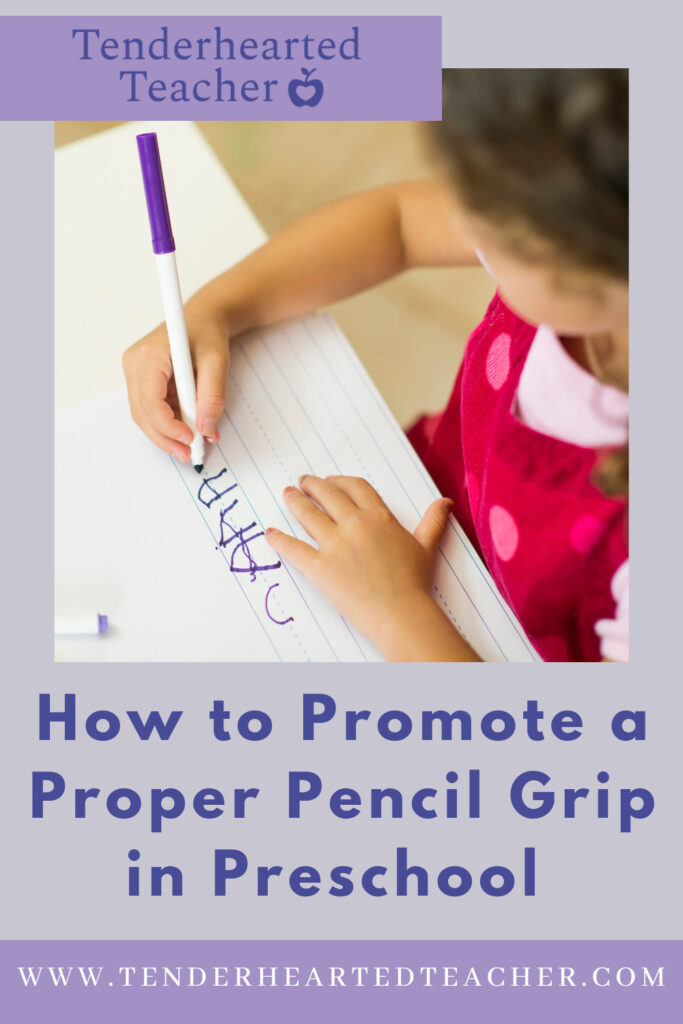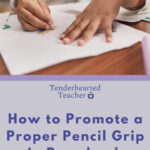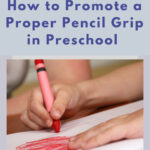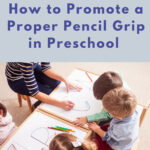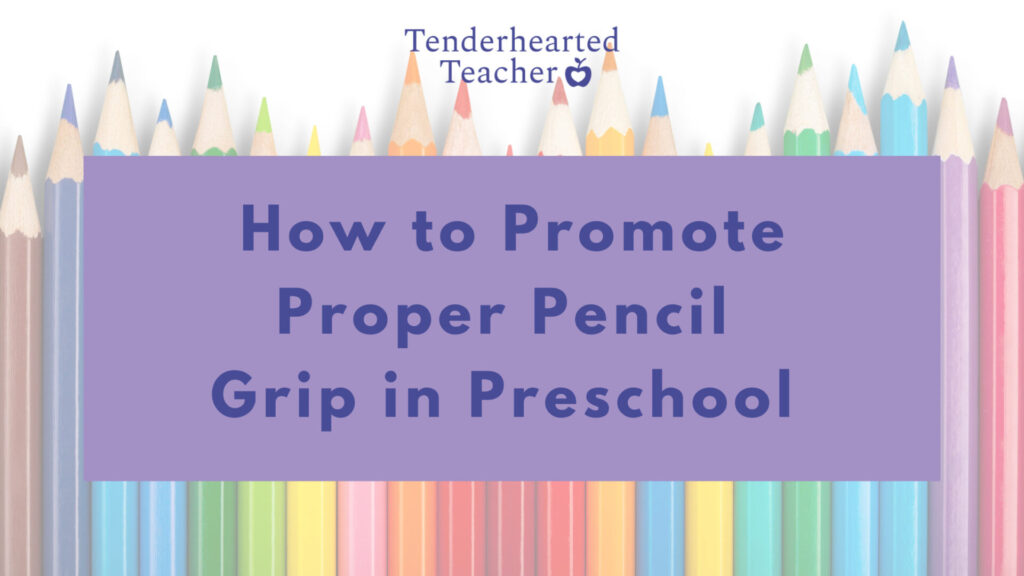
As an early childhood educator, I often get asked about how to teach young children to write. The answer is multi-faceted. A lot of things need to happen developmentally before a child puts a pencil to paper! So, if you haven’t read my posts about the stages of emergent writing as well as my favorite fine motor activities, please check them out for some more information. Today, we’ll focus specifically on pencil grip and what parents can do at home to encourage a proper pencil grasp in preschool.
I chatted with Tracy L. Petrie, OTR/L, a school-based occupational therapist. She provided information about the development stages of pencil grip, what a proper pencil grip looks like, and activities to help prepare our little ones to write!
Developmental Stages of Pencil Grip
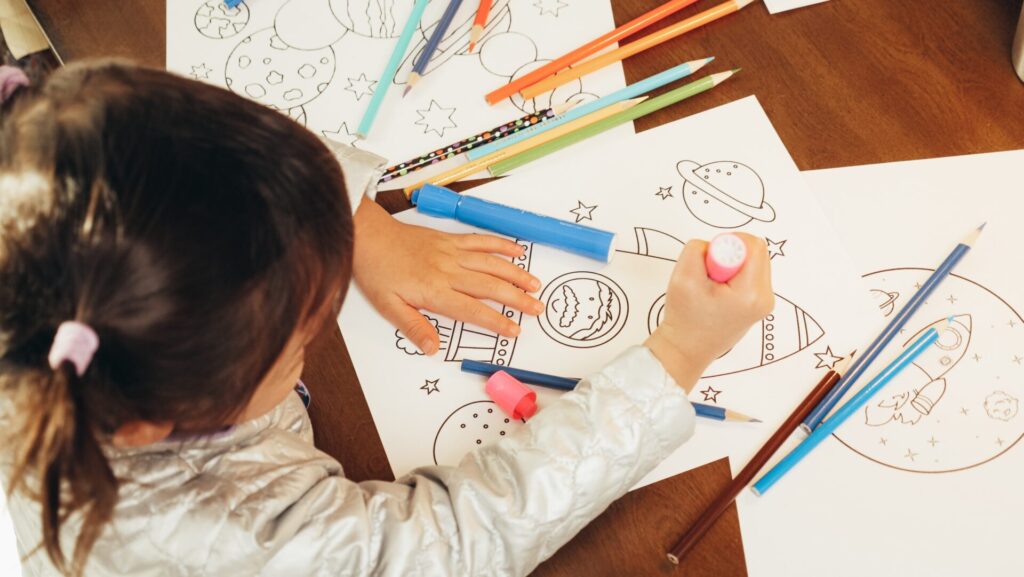
(Photo by Kindel Media via Pexels)
Like so many other skills in early childhood, pencil grasp is developmental and happens in stages. Even small babies start using their hands in ways that will help them down the road with writing. For example, one can observe a pincer grasp (a precursor skill to pencil grip) in young babies as they learn to lift small pieces of food to feed themselves. As time goes on and a child develops more motor strength, they begin to establish hand dominance and progress through these stages.
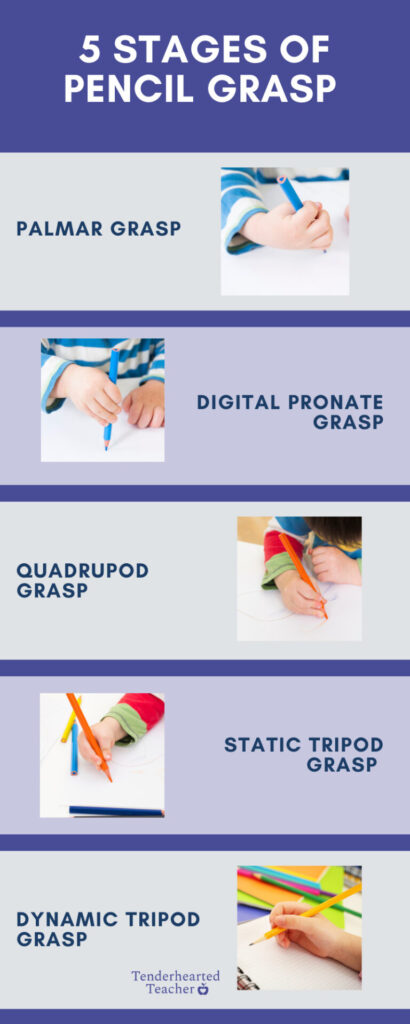
Petrie describes the five stages of pencil grip as follows:
- Palmar grasp: (begins around 12-15 months): when a child wraps their whole hand around the writing utensil like a fist. They create movement with the pencil using their whole arm rather than their fingers.
- Digital pronate grasp: (begins 2-3 years): this is when the child’s fingers start pointing down towards the bottom of the writing utensil. But, the movement is still mostly produced by the arm.
- Quadrupod grasp: (begins 3-4 years): the child begins using four fingers to hold the pencil. Movement is produced from the fingers, wrist, and forearms.
- Static tripod grasp: (begins 3-4 years): the child uses three fingers to hold the utensil, i.e. two fingers pinching the pencil and the 3rd finger tucked to the side.
- Dynamic tripod grasp: (begins 5-6 years): The three fingers are doing most of the writing with minimal wrist and arm movement.
When to Expect a Proper Grasp
A proper grip or the dynamic tripod grasp is generally established around 5 to 6 years old. Petrie states, “This grasp is when the child holds the pencil with the thumb, index, and middle finger. The dynamic component is that the pencil movement is coming from those fingers, rather than the whole wrist and arm.”
In order for children to move successfully through these 5 developmental stages, they need to develop their fine and gross motor skills as well as grasp and manipulate small objects using their fingers. Petrie says, “Prior to pencil grips, the child should be able to pick up and manipulate objects with his/her thumb, index and middle fingers, and isolate just those movements. For example, they need to be able to pick up blocks, goldfish crackers, coins, etc., with just those three digits.”
What to Do at Home to Encourage Pencil Grip in Preschool
There are many things parents can do at home to help their children develop the fine motor strength for a proper pencil grip! Petrie shares 4 of her favorite recommendations and tips for simple, yet meaningful learning experiences.
1. Painting and Drawing
Petrie states, “I typically recommend that preschool friends enjoy fine motor activities without a focus on writing letters, specifically. I love to encourage young children to use sidewalk chalk, broken crayons, golf pencils, pip-squeak markers, and any other shorter utensils.”
Petrie also recommends using these tools on various types of paper like construction paper, notebook paper, post-its, etc. And placing the paper at different angles, i.e. on the floor, tabletop, slant board, easel, or wall. She suggests rolling out a large piece of kraft paper, onto the floor, and letting your child trace your body. Then have them paint or color it in.
Switching it up allows children not only to explore color, shape, and texture but also to develop crucial core, fine motor, and shoulder strength which is necessary for future handwriting. There are countless ways to engage with art materials, so don’t be afraid to get creative!
2. Cooking
Getting your child involved in the kitchen is meaningful in so many ways. They can learn self-care skills, responsibility, new vocabulary, and explore math and science concepts like counting and measuring, temperature, and hot vs. cold. They can also develop the small muscles in their hands and wrists as they pour, cut, roll, measure, and stir. Read more about the benefits of cooking with preschoolers here.
3. Squeeze those muscles
Have your child use tools that encourage squeezing movements like tongs, tweezers, sponges, and spray bottles. Tongs and tweezers can be used to pick up various toys and objects. For example, you can incorporate them into early math games like counting and sorting, i.e. picking up a certain number of toys or separating pom-poms by color. Sponges and spray bottles can be used in sensory tables and even in the bathtub.
4. Stringing Beads
Threading beads, pasta, or cereal, in varying shapes and sizes, onto string is a great way to develop hand-eye coordination, concentration, and fine motor skills. Your child can also practice counting and patterning as they design bracelets and necklaces.
Conclusion
By incorporating these simple fine motor activities into your child’s routine, you can help them develop their pencil grip in preschool in a fun and engaging way. The steps you take now can help your child with conventional writing in the future.
One more thing before I go… if you suspect your child may have fine motor delays, please contact your child’s pediatrician, local school district, or an occupational therapist for an evaluation. You can read more about OT and milestones to look for by checking out my guide to pediatric occupational therapy here.
Now talk to me! What are your favorite types of fine-motor activities to do with your preschooler? Please share them in the comments below.
SAVE TO PINTEREST
